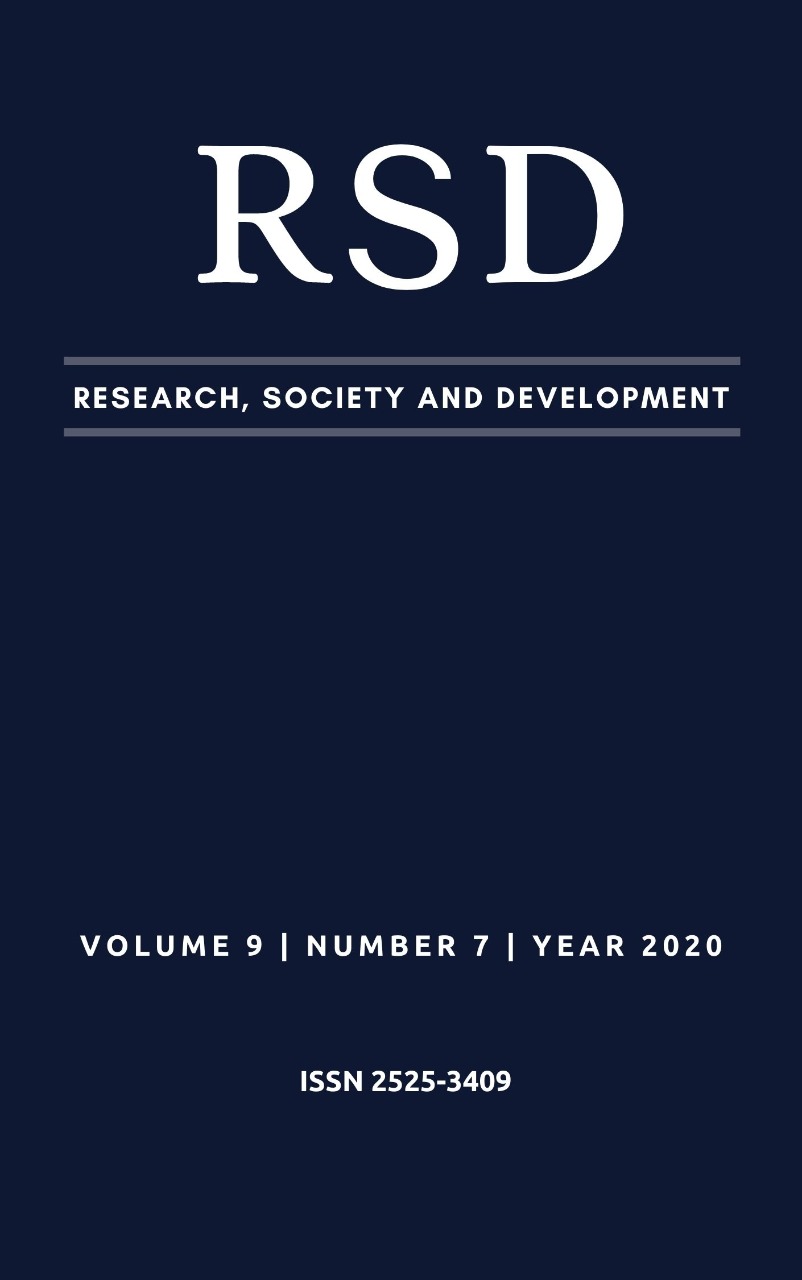Growth and gas exchange in millet under different doses and sources of nitrogen
DOI:
https://doi.org/10.33448/rsd-v9i7.4988Keywords:
Fertilization, Forage, Pennisetum glaucum L, Photosynthesis.Abstract
The objective was to evaluate growth, dry matter production (DMP) and gas exchange of millet, according to different doses and sources of nitrogen. The design was completely randomized in a 5 x 2 factorial scheme, with five nitrogen doses (40; 60; 80; 100 and 120 kg ha-¹ of N) and two sources of N (urea and ammonium sulfate). The evaluations were carried out at 60 and 85 days after seeding (DAS). The variables leaf area (AF), plant height (AP) and DMP at 60 and 85 DAS and stem diameter (SD at 85 DAS) were influenced by the interaction of N sources and doses. The SD at 60 DAS was influenced only doses. Stomatal conductance (gs) and chlorophyll content were influenced by the interaction between sources and doses, while the rate of CO2 assimilation (A) and transpiration (E) were influenced only by the dose. The nitrogen fertilization, in both sources, influenced the growth and the DMP of the millet, in the different periods of development (60 and 85 DAS). Urea showed a better response to gas exchange than ammonium sulfate, except for stomatal conductance. Thus, up to 60 days after seeding, for grazing purpose, between 60 and 80 kg ha-1 of N is recommended, using urea as the source. For the silage production, from 60 to 85 days after seeding, fertilization between 80 and 100 kg ha-1 of N in the form of urea is recommended.Downloads
References
Blackmer TM & Schepers JS. (1994). Techniques for monitoring crop nitrogen status in corn. Communications in soil science and plant analysis, 25(9-10), 1791-800.
Carmo MS, Cruz SCS, Souza EJ, Campos LFC & Machado CG. (2012). Doses e fontes de nitrogênio no desenvolvimento e produtividade da cultura de milho doce (Zea mays convar. saccharata var. rugosa). Bioscience Journal, 28(1), 223-31.
Guimarães Júnior R, Gonçalves LC, Rodrigues JAS, Pires DAA, Jayme DG, Rodriguez NM & Saliba EOS. (2009). Avaliação agronômica de genótipos de milheto (P. glaucum) plantados em período de safrinha. Archivos de zootecnia, 58(1), 629-632.
Goes, RJ, Rodrigues RAF, Arf O, Arruda OG & Vilela RG. (2011). Fontes e doses de nitrogenio em cobertura, no sorgo granifero na safrinha. Revista Brasileira de Milho e Sorgo, 10(2), 121-129.
Heringer I & Moojen EL. (2002). Potencial produtivo, alterações da estrutura e qualidade da pastagem de milheto submetida a diferentes níveis de nitrogênio. Revista Brasileira de Zootecnia, 31(2), 875-882.
Lopes MN, Cândido MJD, Pompeu RCFF, SILVA RG, LACERDA CF, Bezerra MA & Carneiro MS. (2020). Gas exchange in Massai grass fertilized with nitrogen and grazed by sheep. Bioscience Journal, 36(1), 152-160.
Marcante NC, Camacho MA & Paredes FPJ. (2011). Teores de nutrientes no milheto como cobertura de solo. Bioscience Journal, 27(2), 196-204.
Melo NC, Fernandes AR & Galvão JR. (2015). Crescimento e eficiência nutricional do nitrogênio em cultivares de milheto forrageiro na Amazônia. Revista Caatinga, 28(3), 68-78.
Minolta C. (1989). Manual for chlorophyll meter SPAD-502. Osaka: Minolta Radiometric Instruments Divisions.
Negreiros Neto JV, Santos AC, Leite RL & Cruz RS. (2010). Análise de diferentes doses de nitrogênio e espaçamento em milheto no norte do Tocantins. Biotemas, 23(4), 19-23.
Pereira Filho IA, Ferreira ADS, Coelho AM, Casela CR, Karam D, Rodrigues JAS & Waquil JM. (2003). Manejo da cultura do milheto. Sete Lagoas: Embrapa Milho e Sorgo.
Payne, WA, Wendt, CW, Hossner, LR & Gates, CE. (1991). Estimating pearl millet leaf area and specific leaf area. Agronomy Journal, 83(6), 937-941.
Pompeu RCFF, Cândido MJD, Lopes MN, Gomes FHT, Lacerda CFD, Aquino BF & Magalhães JA. (2010). Características morfofisiológicas do capim-aruana sob diferentes doses de nitrogênio. Revista Brasileira de Saúde e Produção Animal, 11(4), 1187-1210.
Rocha JMR, Santos A, Silveira Júnior O, Silva R, Santos J & Oliveira L. (2017). Características agronômicas do milheto sob efeito ne nitrogênio nos sistemas consorciado e monocultivo. Revista Tecnologia e Ciência Agropecuária, 11(1), 37-43.
Rodrigues RC, Saramuzza WLMP, Jesus APRD, Lima DDOS, Siqueira JCD, Plese LPDM. & Cabral LDS. (2012). Produção e morfofisiologia do capim Brachiaria Brizantha Cv. Xaraés sob doses de nitrogêncio e fósforo. Revista Brasileira de Agropecuária Sustentável, 2(1), 124-131.
Silva, DJ & Queiroz, AC. (2002). Análise de alimentos: métodos químicos e biológicos. Viçosa: Editora UFV.
Taiz L, Zeiger E, Moller IM & Murphy A. (2017). Fisiologia e desenvolvimento vegetal. Porto Alegre: Artmed.
Theago EQ, Buzetti S, Teixeira Filho MCM, Andreotti M, Megda MM & Benett CGS. (2014). Doses, fontes e épocas de aplicação de nitrogênio influenciando teores de clorofila e produtividade do trigo. Revista Brasileira de Ciência do Solo, 38(6), 1826-1835.
Valderrama M, Buzetti S, Teixeira Filho MCM, Benett CGS & Andreotti M. (2014). Adubação nitrogenada na cultura do milho com ureia revestida por diferentes fontes de polímeros. Semina: Ciências Agrárias, 35(2), 659-69.
Waraich EA, Ahmad R, Ashraf MY, Saifullah & Ahmad M. (2011). Improving agricultural water use efficiency by nutrient management in crop plants. Acta Agriculturae Scandinavica, Section B-Soil & Plant Science, 61(4), 291-304.
Downloads
Published
Issue
Section
License
Authors who publish with this journal agree to the following terms:
1) Authors retain copyright and grant the journal right of first publication with the work simultaneously licensed under a Creative Commons Attribution License that allows others to share the work with an acknowledgement of the work's authorship and initial publication in this journal.
2) Authors are able to enter into separate, additional contractual arrangements for the non-exclusive distribution of the journal's published version of the work (e.g., post it to an institutional repository or publish it in a book), with an acknowledgement of its initial publication in this journal.
3) Authors are permitted and encouraged to post their work online (e.g., in institutional repositories or on their website) prior to and during the submission process, as it can lead to productive exchanges, as well as earlier and greater citation of published work.


